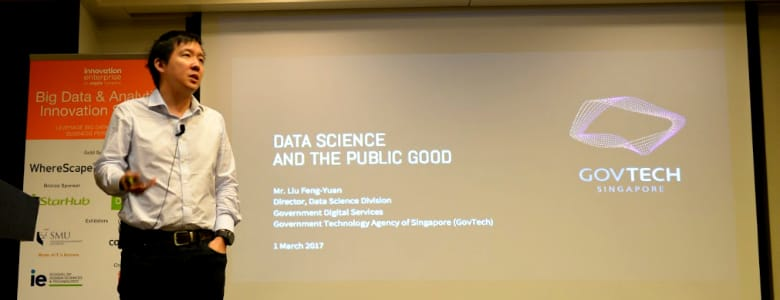Serving citizens better with Big Data

From helping public libraries target specific groups of borrowers to catching rogue MRT trains, the possibilities are endless when government agencies use data science for the public good.
Speaking on 1 March at the Big Data & Analytics Innovation Summit 2017, Mr Liu Feng-Yuan, Director of GovTech’s Government Digital Services (GDS) Data Science Division, pointed to these examples to illustrate the Singapore government’s efforts at using data to drive decision making.
Some 250 data scientists, engineers, marketers and executives from a variety of industries attended the Summit, which was organised by business media company, Innovation Enterprise.
The Summit also featured some 35 speakers from the industry, including familiar names such as Uber, Sephora and Spotify, sharing case studies in using big data.
Mr MC Srivas, chief data architect at Uber, spoke about how the company uses real-time analytics to guide its ride-sharing operations, while Mr Adrien Eudes, head of data at Sephora, spoke about how businesses can use web analytics to better understand their customers.
And what could be music to the ears of media analysts, Ms Joanna Wong, Spotify’s head of business marketing for Asia Pacific, shared that the company now has data from more than 100 million active users worldwide, which translates to 25 billion hours of music streamed.
Beyond going by the book
In his keynote, Mr Liu stressed that applying data science to public policy is a multidisciplinary endeavour.
Technical expertise in areas such as computational methods, data visualisation, statistics and machine learning is required; at the same time, the team must also be able to communicate their findings to policy-makers, executives and operations teams.
GovTech has used computational techniques to help agencies such as the National Library Board (NLB) better understand their customers.
By running data clustering algorithms on NLB’s 20 million anonymised borrowing records, data scientists were able to distinguish between groups of borrowers that on the surface looked very similar.
Elderly borrowers, for example, are not all alike. One group — probably retirees leading an active lifestyle — tend to borrow books from library branches located downtown, on hobbies such as photography.
A separate group tend to borrow children’s books from library branches in mature housing estates — these people are likely to be retirees who look after their grandchildren.
“You would tend to think that these groups are homogenous,” said Mr Liu.
“The lesson learned is that our usual mental stereotypes of customers might be very different after speaking to the data scientists.”
This information allows NLB to plan activities and programmes that target more specific groups of customers, he added.
Figures of Speech
It is not just mountains of numerical data that can be tapped.
Machine learning and natural language processing techniques can also help government agencies make sense of textual data.
By analysing the text of all parliamentary speeches made since Singapore gained independence in 1965, GovTech’s data scientists were able to detect patterns that show how national priorities have evolved over time, said Mr Liu.
During the years immediately after independence, for example, there was much discussion about rural and urban redevelopment issues.
But in more recent parliaments, discussion of societal issues and public feedback took centre stage, he said.
The team ran a similar analysis on the text of hundreds of thousands of feedback emails sent by the public to the Housing Development Board (HDB).
They found that they could better classify the emails into distinct topics, which could then be addressed.
“It turned out that key collection was a major issue, making up about one third of the feedback HDB received,” said Mr Liu.
Based on this analysis, HDB changed its key collection process: Rather than assign collection dates, the HDB now allows homeowners to select a date to collect their keys.
Driving citizens to use data
GovTech’s data scientists have also had a hand in changing the face of public transport in Singapore.
They played a key role in pinpointing the source of the 2016 Circle Line breakdowns — a multi-agency achievement that has since garnered both national and international attention.
In addition, together with the Land Transport Authority (LTA) and private bus operators, GovTech developed Beeline, a platform which lets people book seats on direct bus routes, and to crowdsource new routes, via a mobile app.
“This is a different way of getting citizens involved in transportation planning, rather than it just being from the top down,” said Mr Liu.
Simple, user-centric designs, he added, would help encourage the public to adopt technology initiatives such as Beeline as part of their daily lives.
https://www.tech.gov.sg/media/technews/serving-citizens-better-with-big-data
